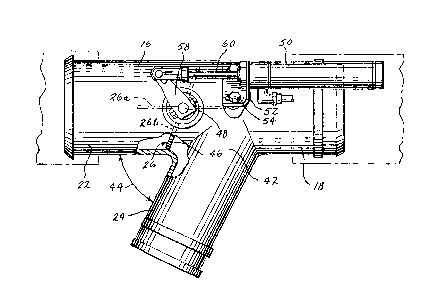Une partie des informations de ce site Web a été fournie par des sources externes. Le gouvernement du Canada n'assume aucune responsabilité concernant la précision, l'actualité ou la fiabilité des informations fournies par les sources externes. Les utilisateurs qui désirent employer cette information devraient consulter directement la source des informations. Le contenu fourni par les sources externes n'est pas assujetti aux exigences sur les langues officielles, la protection des renseignements personnels et l'accessibilité.
L'apparition de différences dans le texte et l'image des Revendications et de l'Abrégé dépend du moment auquel le document est publié. Les textes des Revendications et de l'Abrégé sont affichés :
| (12) Brevet: | (11) CA 1285829 |
|---|---|
| (21) Numéro de la demande: | 1285829 |
| (54) Titre français: | MECANISME SELECTEUR D'ECHAPPEMENT POUR PROPULSEUR ARRIERE DE BATEAU |
| (54) Titre anglais: | EXHAUST CONTROL ASSEMBLY FOR MARINE STERN DRIVE |
| Statut: | Durée expirée - après l'octroi |
| (51) Classification internationale des brevets (CIB): |
|
|---|---|
| (72) Inventeurs : |
|
| (73) Titulaires : |
|
| (71) Demandeurs : |
|
| (74) Agent: | RICHARD J. MITCHELLMITCHELL, RICHARD J. |
| (74) Co-agent: | |
| (45) Délivré: | 1991-07-09 |
| (22) Date de dépôt: | 1987-12-16 |
| Licence disponible: | S.O. |
| Cédé au domaine public: | S.O. |
| (25) Langue des documents déposés: | Anglais |
| Traité de coopération en matière de brevets (PCT): | Non |
|---|
| (30) Données de priorité de la demande: | ||||||
|---|---|---|---|---|---|---|
|
ABSTRACT
A stern drive marine propulsion system
nas an inboard engine with an exhaust , an
outboard drive unit operatively coupled to the
engine and separated therefrom by a transom
having two exhaust passages therethrough,
and an exhaust control assembly aft of the engine
exhaust and forward of the transom and within
the boat . The assembly has an inlet
connected to the engine exhaust , and has first and
second outlets communicating with the re-
spective exhaust passages extending aft
through the transom . A valve in the as-
sembly selectively controls communication of the
inlet with the first outlet .
Note : Les revendications sont présentées dans la langue officielle dans laquelle elles ont été soumises.
Note : Les descriptions sont présentées dans la langue officielle dans laquelle elles ont été soumises.

2024-08-01 : Dans le cadre de la transition vers les Brevets de nouvelle génération (BNG), la base de données sur les brevets canadiens (BDBC) contient désormais un Historique d'événement plus détaillé, qui reproduit le Journal des événements de notre nouvelle solution interne.
Veuillez noter que les événements débutant par « Inactive : » se réfèrent à des événements qui ne sont plus utilisés dans notre nouvelle solution interne.
Pour une meilleure compréhension de l'état de la demande ou brevet qui figure sur cette page, la rubrique Mise en garde , et les descriptions de Brevet , Historique d'événement , Taxes périodiques et Historique des paiements devraient être consultées.
| Description | Date |
|---|---|
| Inactive : CIB désactivée | 2011-07-26 |
| Inactive : CIB désactivée | 2011-07-26 |
| Inactive : CIB de MCD | 2010-02-01 |
| Inactive : CIB de MCD | 2010-02-01 |
| Inactive : CIB expirée | 2010-01-01 |
| Inactive : CIB expirée | 2010-01-01 |
| Inactive : Périmé (brevet sous l'ancienne loi) date de péremption possible la plus tardive | 2008-07-09 |
| Inactive : CIB de MCD | 2006-03-11 |
| Inactive : CIB de MCD | 2006-03-11 |
| Inactive : CIB de MCD | 2006-03-11 |
| Accordé par délivrance | 1991-07-09 |
Il n'y a pas d'historique d'abandonnement
| Type de taxes | Anniversaire | Échéance | Date payée |
|---|---|---|---|
| TM (catégorie 1, 6e anniv.) - générale | 1997-07-09 | 1997-06-18 | |
| TM (catégorie 1, 7e anniv.) - générale | 1998-07-09 | 1998-06-17 | |
| TM (catégorie 1, 8e anniv.) - générale | 1999-07-09 | 1999-06-16 | |
| TM (catégorie 1, 9e anniv.) - générale | 2000-07-10 | 2000-06-19 | |
| TM (catégorie 1, 10e anniv.) - générale | 2001-07-09 | 2001-06-20 | |
| TM (catégorie 1, 11e anniv.) - générale | 2002-07-09 | 2002-06-18 | |
| TM (catégorie 1, 12e anniv.) - générale | 2003-07-09 | 2003-06-18 | |
| TM (catégorie 1, 13e anniv.) - générale | 2004-07-09 | 2004-06-18 | |
| TM (catégorie 1, 14e anniv.) - générale | 2005-07-11 | 2005-06-20 | |
| TM (catégorie 1, 15e anniv.) - générale | 2006-07-10 | 2006-06-16 | |
| TM (catégorie 1, 16e anniv.) - générale | 2007-07-09 | 2007-06-07 |
Les titulaires actuels et antérieures au dossier sont affichés en ordre alphabétique.
| Titulaires actuels au dossier |
|---|
| BRUNSWICK CORPORATION |
| Titulaires antérieures au dossier |
|---|
| ARVID E. WINBERG |
| JOHN J. LITJENS |